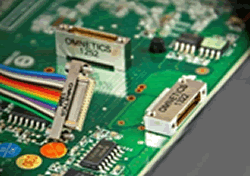Five Fundamentals for Designing With MIL-DTL-32139 Nano-D Connectors
Nano-D connectors rival their larger Micro-D counterparts in portable, high-density, ruggedized electronics
By Bob Stanton, Omnetics Connector Corp., www.omnetics.com

Nano-D connectors.
New military electronics are continuing to embrace more portable, higher-density ruggedized electronics. Rapid deployment of electronic ground troops, hand-launched surveillance drones, as well as geophysical tracking and reporting systems have taken control of the battlespace that we face. Customized processing chips offer multiple functions crammed into one highly densified module. These chips often run on starvation current levels to save power, and voltages are similarly low despite offering surprisingly high-speed digital processing data and control information. In turn, the connector and cable systems that route data from one module to the next must follow suit, offering minimal size and weight while maintaining flexibility of use. Interconnects must also pass the rigors of being rugged and reliable in the face of a wide range of environmental conditions, such as mud, sand, dust, and wide temperature ranges. In addition, many applications are near or exposed to other signal processing systems that could compromise the overall system performance. This adds the need for electromagnetic shielding and or signal isolation. Circuit designers must therefore select connectors and cable systems that address several different performance challenges.
Rectangular Micro-D connectors, and specifically MIL-DTL-83513 connectors, have conquered most of these performance challenges and continue to offer a proven source of smaller and somewhat compact interconnect systems. However, with the military’s push towards more SWaP-friendly (size, weight, and power) interconnects, we are seeing a shift towards the somewhat equivalent, but smallerMIL-DTL-32139 Nano-D connectors. By comparison, a 25-position Micro-D weighs over 47g, while a 25-position Nano-D connector weighs only 12g and has one-eighth the volume of a comparable Micro-D. Micro-D connectors are built with a pin-to-pin spacing (i.e., pitch) of .050” (1.28mm), which demands similar board layout space. Unlike other connectors that connect to a PCB, the pitch for Nano-D connectors is set at .025” (0.64mm) pin-to-pin spacing, and the board layout required is half that of Micro-Ds.
Some critical points to remember when designing with nano-connectors include:
- The maximum wire size is 30 or 32AWG. The current flow will then be limited to 1A maximum, depending on the percent of time the current is flowing. The contact resistance from pin to socket will be at about 15 mΩ, and it will require 2oz to 3oz of mating force per pin.
- Backshells are available to connect shielded braiding from cable to shells. These provide EMI and crosstalk from cable to cable or within the instrumentation. Slip-on shielding offers 60dB of shielding, and special over-braid machines can offer tighter shield windings and provide up to 90dB of shielding.
- Mating and de-mating ratings in the Nano-D military specification only require 200 mates before the plating may be compromised, increasing contact resistance. However, some Nano-D connector suppliers offer over 2,000 mates before plating fails to provide more useful lifetimes for frequently used connectors. The plating should be specified to meet ASTBM B488 Type II which includes 50 microinches (µin) of gold over 50µin of nickel.
- Nano-D connectors withstand shock and vibration better than Micro-D connectors due to their low weight. Since force and acceleration are key factors, the lower weight nano-connectors have passed extreme shock tests that Micro-D connectors do not. In fact, Nano-D connectors have been tested and used in high shock (above 10,000G) conditions, such as when fired from military ballistic devices like THAAD missile interceptor systems. Their extreme temperature ranges are also similar to Micro-D connectors, and they easily pass operating temperatures of -55°C to +200°C.
-

Nano-D latching connectors.
The new latching Nano-D connectors have tested to be stronger in strength-and-hold tests beyond the older jackscrew varieties. These latching systems allow for easier connection in field applications.

SWaP Micro-D and Nano-D connectors.
New SWaP-friendly applications for both Micro-D and Nano-D military connectors are also evolving rapidly. These designs are often tailored versions of current military standard connectors. Note the photo that shows higher power lines inserted side by side with high-speed signal lines. This reduces size as well as the number of cables within the interconnection system. Most often, designers contact connector suppliers and fast-look solid models are crafted for system analysis. When approved, the materials and manufacturing is rather straightforward, as they follow current standards and use current materials already in the connector manufacturing plant.
Nano-D connectors designed into military products are exceptionally effective at solving many of the problems with portability and use in rugged applications. Circuit levels are offering more performance while demanding lower current and voltages, and Nano-D connector and cable systems are filling these needs.
Recently posted:
[related_posts limit=”10″]






